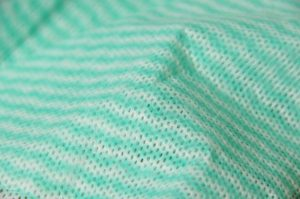Nonwoven fabric is composed of directional or random fibers. It is a new generation of environmentally friendly materials. It is moisture-proof, breathable, flexible, light in weight, non-combustible, easy to decompose, non-toxic and non-irritating, rich in color Inexpensive and recyclable. For example, polypropylene (pp material) pellets are used as raw materials, and are produced by a continuous one-step method of high temperature melting, spinning, laying, and hot pressing and coiling.
It is called cloth because of its appearance and certain properties.
The producers of non-woven fabrics are mainly concentrated in the United States (41% of the world), Western Europe accounts for 30%, Japan accounts for 8%, China's production only accounts for 3.5% of the world's production, but its consumption is 17.5% of the world's . It is estimated that by 2007, China's production will reach 7% of the world's production, and its consumption will increase to 21% of the world's.
At present, man-made fibers still dominate the production of nonwovens, and before 2007, this situation will not change significantly. 63% of the fibers used in the production of nonwovens worldwide are polypropylene, 23% polyester, 8% viscose, 2% acrylic, 1.5% polyamide and the remaining 3% are others fiber.
In recent years, the application of non-woven fabrics in sanitary absorbent materials, medical, transportation, and shoe-making textile materials has increased significantly.

Nonwoven production and consumption
The global consumption of non-woven fabrics was 800,000 tons in 1983, and increased to 110 tons in 1985, 1.4 million tons in 1988, and 2.4 million tons in 1998. It is estimated that by 2005 Annual, its consumption can reach 3.7 million tons.
The consumption of man-made fibers used in various textiles was 16.9 million tons in 1983, increased to 20.4 million tons in 1988, and reached 30.4 million tons in 1998. It is estimated that by 2005, its consumption will be 37 million tons. It can reach 38.3 million tons per year.
The consumption growth rate of man-made fibers in non-woven production is expected to reach 10% in 2005 and 10.4% in 2007. Part of the reason for such rapid growth in consumption in the nonwovens industry is the increase in ancillary industries in China, Southeast Asia, Latin America and the Middle East.
Factors affecting the growth rate of nonwoven fabrics
All factors that affect the growth of man-made fibers can more or less have a certain impact on textiles made of man-made fibers, among which non-woven textiles have the greatest impact. Population growth factors have less impact on non-woven fabrics than other textiles used for apparel. But if one considers the important application of nonwovens in baby diapers, population growth is also an important factor. The replacement of natural fibers has a greater impact on textiles, but has little impact on non-woven fabrics, because the production of non-woven fabrics basically depends on man-made fibers.
Commercial development of man-made fibers and professional application of non-woven fabrics: Due to the establishment of international economic treaties, the trade in microfibers, composite fibers, biodegradable fibers and new polyester fibers has grown. This has a great impact on non-woven fabrics, but has little impact on apparel and knitted textiles. Substitution of textiles and other items: This includes substitution by non-woven textiles, knitted textiles, plastic films, polyurea foam, wood pulp, leather, etc. This is determined by the cost and performance requirements that the product needs to have. The introduction of new, more economical and efficient production processes: namely, various articles made from polymers, the application of new competitive non-woven fabrics, and the introduction of special fibers and additives for non-woven textiles.
The three major fibers used in non-woven production are polypropylene fibers (62% of the total), polyester fibers (24% of the total) and viscose fibers (8% of the total). Between 1970 and 1985, viscose fiber was the most used in the production of non-woven fabrics. However, in the past five years, in the field of sanitary absorbent materials and medical textiles, the application of polypropylene fibers and polyester fibers has begun to dominate. In the early non-woven production market, nylon was used in a large amount, and since 1998, the use of acrylic fibers began to rise, especially in the field of artificial leather manufacturing.
Features
Non-woven fabric is a kind of non-woven fabric, which directly uses polymer chips, short fibers or filaments to form fibers through air flow or machinery, and then undergoes hydroentanglement, needle punching, or hot rolling reinforcement, and finally after finishing Formed non-woven fabric. A new type of fiber product with a soft, breathable and flat structure, the advantages are that it does not produce lint, is strong, durable, silky soft, and has a cotton feel. Compared with cotton fabrics, non-woven bags are easy to form, and Cheap.
In terms of environmental protection, the raw material of most of the non-woven fabrics currently used is polypropylene, while the raw material of plastic bags is polyethylene. Although the two substances have similar names, they are quite different in chemical structure. The chemical molecular structure of polyethylene has strong stability and is extremely difficult to degrade, so it takes 300 years for plastic bags to decompose; while the chemical structure of polypropylene is not strong, the molecular chain can be easily broken, so it can be effectively degraded , and enter the next environmental cycle in a non-toxic form, a non-woven shopping bag can be completely decomposed within 90 days. And non-woven shopping bags can be reused more than 10 times, and the pollution to the environment after disposal is only 10% of that of plastic bags. There is also non woven fabric slitting machine for you to choose. Don’t hesitate to click the link to discover more.




